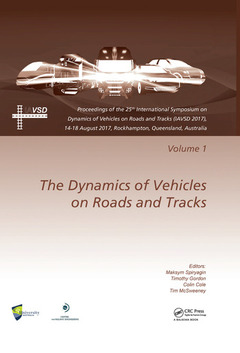Description
Dynamics of Vehicles on Roads and Tracks Vol 1
Proceedings of the 25th International Symposium on Dynamics of Vehicles on Roads and Tracks (IAVSD 2017), 14-18 August 2017, Rockhampton, Queensland, Australia
Coordinators: Spiryagin Maksym, Gordon Timothy, Cole Colin, McSweeney Tim
Language: English
Subjects for Dynamics of Vehicles on Roads and Tracks Vol 1:
· 17.4x24.6 cm · Hardback
Description
/li>Contents
/li>Readership
/li>Biography
/li>
The International Symposium on Dynamics of Vehicles on Roads and Tracks is the leading international gathering of scientists and engineers from academia and industry in the field of ground vehicle dynamics to present and exchange their latest innovations and breakthroughs. Established in Vienna in 1977, the International Association of Vehicle System Dynamics (IAVSD) has since held its biennial symposia throughout Europe and in the USA, Canada, Japan, South Africa and China. The main objectives of IAVSD are to promote the development of the science of vehicle dynamics and to encourage engineering applications of this field of science, to inform scientists and engineers on the current state-of-the-art in the field of vehicle dynamics and to broaden contacts among persons and organisations of the various countries engaged in scientific research and development in the field of vehicle dynamics and related areas.
IAVSD 2017, the 25th Symposium of the International Association of Vehicle System Dynamics was hosted by the Centre for Railway Engineering at Central Queensland University, Rockhampton, Australia in August 2017. The symposium focused on the following topics related to road and rail vehicles and trains: dynamics and stability; vibration and comfort; suspension; steering; traction and braking; active safety systems; advanced driver assistance systems; autonomous road and rail vehicles; adhesion and friction; wheel-rail contact; tyre-road interaction; aerodynamics and crosswind; pantograph-catenary dynamics; modelling and simulation; driver-vehicle interaction; field and laboratory testing; vehicle control and mechatronics; performance and optimization; instrumentation and condition monitoring; and environmental considerations.
Providing a comprehensive review of the latest innovative developments and practical applications in road and rail vehicle dynamics, the 213 papers now published in these proceedings will contribute greatly to a better understanding of related problems and will serve as a reference for researchers and engineers active in this specialised field. Volume 1 contains 78 papers under the subject heading Road.
dynamics and stability
vibration and comfort
suspension
steering
traction and braking
active safety systems
advanced driver assistance systems
autonomous road and rail vehicles
adhesion and friction
wheel-rail contact
tyre-road interaction
aerodynamics and crosswind
pantograph-catenary dynamics
modelling and simulation
driver-vehicle interaction
field and laboratory testing
vehicle control and mechatronics
performance and optimisation
instrumentation and condition monitoring
environmental considerations
Maksym Spiryagin is the Deputy Director of the Centre for Railway Engineering at Central Queensland University. He received his PhD in the field of Railway Transport in 2004 at the East Ukrainian National University. Professor Spiryagin’s involvement in academia and railway industry projects includes research experience in Australia, China, Italy, South Korea and Ukraine involving locomotive design and traction, rail vehicle dynamics, acoustics and real-time and software-enabled control systems, mechatronics and the development of complex mechatronic systems using various approaches (co-simulation, software-in-the-loop, processor-in-the-loop or hardware-in-the loop simulations). He has published four books and has more than 130 other scientific publications and twenty patents as one of the inventors.
Timothy Gordon is Head of the School of Engineering in the College of Science at the University of Lincoln which he joined in 2014 having spent ten years at the University of Michigan (UM) as Professor of Mechanical Engineering in the College of Engineering and heading UM’s Transportation Research Institute (UMTRI) as head of the Engineering Research Division. He was formerly Ford Professor of Automotive Engineering at Loughborough University and has worked extensively with the automotive industry. He received his PhD in Relativistic Field Theory in 1978 from the Department of Applied Mathematics and Theoretical Physics at the University of Cambridge. His research covers all aspects of active safety of road vehicles including how computer control systems can help reduce crashes and the development of autonomous safety systems. Particular interests are the development and application on non-linear optimal control methods for areas such as collision avoidance, vehicle dynamics at the limits of friction, as well as broader aspects such as optimal energy efficiency. Another special area of interest is in analysis and modelling of




